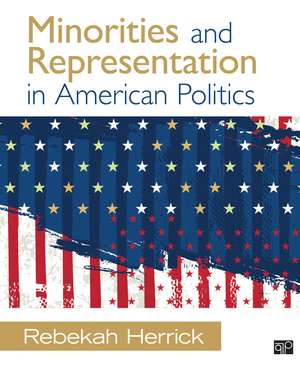Minorities and Representation in American Politics
Autor Rebekah L. Herricken Limba Engleză Paperback – 18 apr 2016
Preț: 538.64 lei
Preț vechi: 727.89 lei
-26% Nou
Puncte Express: 808
Preț estimativ în valută:
103.08€ • 107.22$ • 85.10£
103.08€ • 107.22$ • 85.10£
Carte tipărită la comandă
Livrare economică 14-28 aprilie
Preluare comenzi: 021 569.72.76
Specificații
ISBN-13: 9781483386836
ISBN-10: 148338683X
Pagini: 448
Dimensiuni: 191 x 232 x 21 mm
Greutate: 0.68 kg
Ediția:1
Editura: SAGE Publications
Colecția CQ Press
Locul publicării:Washington DC, United States
ISBN-10: 148338683X
Pagini: 448
Dimensiuni: 191 x 232 x 21 mm
Greutate: 0.68 kg
Ediția:1
Editura: SAGE Publications
Colecția CQ Press
Locul publicării:Washington DC, United States
Recenzii
“Minorities and Representation in American Politics is the most comprehensive treatment of minorities in politics that I have ever read. Herrick is able to cover multiple minority groups and does it in a fashion that does not neglect any of the relevant points that need to be addressed in a book of this kind. The scope of the text is sweeping, and it has no rival on the market.”
“Minorities and Representation in American Politics comprehensively integrates discussion of race, gender, ethnicity, and intersectionality. In doing so, it facilitates the comparison and contrast of experiences of minority statuses far more effectively than other textbooks. The representational lens through which the text explores minorities in politics nicely ties together the different groups and themes, and Herrick does a great job of introducing relevant empirical research from inside and outside of political science.”
“Rebekah Herrick is able to highlight many interesting facets of the minority experience without overwhelming the reader. It is hard for me to believe that there is any other book out there that provides such a detailed, thoughtful analysis as Minorities and Representation in American Politics.”
“Herrick’s text provides a comprehensive examination of the distinctive minority groups within the U.S. political system and brilliantly navigates the intersectionality of gender and race/ethnicity with representation. While the book addresses many fundamental topics of minorities and covers a wide spectrum of the political institutions and behavioral aspects of representation in the United States, it also captures much of the recent scholarly debate and research in a way that remains accessible to the undergraduate.”
“Minorities and Representation in American Politics comprehensively integrates discussion of race, gender, ethnicity, and intersectionality. In doing so, it facilitates the comparison and contrast of experiences of minority statuses far more effectively than other textbooks. The representational lens through which the text explores minorities in politics nicely ties together the different groups and themes, and Herrick does a great job of introducing relevant empirical research from inside and outside of political science.”
“Rebekah Herrick is able to highlight many interesting facets of the minority experience without overwhelming the reader. It is hard for me to believe that there is any other book out there that provides such a detailed, thoughtful analysis as Minorities and Representation in American Politics.”
“Herrick’s text provides a comprehensive examination of the distinctive minority groups within the U.S. political system and brilliantly navigates the intersectionality of gender and race/ethnicity with representation. While the book addresses many fundamental topics of minorities and covers a wide spectrum of the political institutions and behavioral aspects of representation in the United States, it also captures much of the recent scholarly debate and research in a way that remains accessible to the undergraduate.”
Cuprins
Chapter 1: Minorities and Representation
Who Are Minorities?: Race as a Category
Who Are Minorities?: Ethnicity as a Category
Who Are Minorities?: Gender and Sexual Minorities
Representation
Overview of the Book
Conclusion: Similarities, Differences, and Intersectionality in Representation
Chapter 2: Descriptive Representation and Minorities: Legislatures and Other Elective Offices
Levels of Descriptive Representation in Legislatures
Levels of Descriptive Representation in Executive Positions
What Affects Levels of Descriptive Representation?
Descriptive Representation is Not Sufficient
Conclusion: Similarities, Differences, and Intersectionality
Chapter 3: Minorities and Formalistic Representation: Laws, Institutional Design, and Elections
Formal Representation and the Right to Vote
Electoral Systems
Institutional Design
The Fourteenth Amendment
Conclusion: Similarities, Differences, and Intersectionality
Chapter 4: Policy Representation and Minorities in Legislatures
Key Minority Policy Interests
Does Descriptive Representation Lead to Substantive Representation?
What Affects Policy Representation?
Initiative and Referenda Effects on Minority Interests
Demonstration
Casework/Constituency Services and Pork Barreling by Minority Legislators
Conclusion: Similarities and Differences in Policy Representation
Chapter 5: Minorities and Symbolic Representation
Measuring Minorities' Attitudes
Levels of Symbolic Representation
What Affects the Symbolic Representation of Minorities?
Symbolic Legislation: Representing Minorities through Symbolic Actions
Conclusion: Decreasing Gaps in Symbolic Representation
Chapter 6: Minority Representation and the Judicial Branch
The Court Systems
Descriptive Representation: The Numbers Game
What Affects Descriptive Representation in the Judicial Branch?
Descriptive and Substantive Representation on the Courts
Key Court Cases
Conclusion: Improving Descriptive Representation but Mixed Record of Courts’ Protection of Minorities
Chapter 7: Representative Bureaucracy
The Influence of Bureaucrats on Policy
Level of Passive Representation
What Affects Passive Representation?
The Effects of Passive Representation on Active Representation
Conclusion: Similarities and Differences in Minority Representation in the Bureaucracy
Chapter 8: Public Opinion and Minority Interests
Attitudes Toward Racial and Ethnic Minorities
Attitudes Toward Women
Attitudes Toward LGBT Persons
Attitudes Toward Affirmative Action
Attitudes Toward LGBT Issues
Attitudes Toward Abortion
Attitudes Toward Immigration
Social Desirability Biases in Surveys
Influences on Americans' Attitudes Toward Minority Interests
Conclusion: Varied but Increasing Acceptance of Minorities and Their Issues
Chapter 9: Minority Groups and Political Resources
Size and Distribution of Minority Populations
The Voting Eligibility of American Minorities
The Socioeconomic Status of Minorities
The Civic Engagement of Minorities
Conclusion: Variation among Groups in Their Resources
Chapter 10: Acculturation, Group Consciousness, and Cohesion among Individuals with Shared Minority Status
Acculturation: The Extent to Which Minorities Are Part of the Dominant Culture
Group Consciousness: The Extent to Which Minorities See Group Status as Politically Important
Group Cohesion: Level of Shared Beliefs, Values, and Attitudes among Individual Minorities
Variation by Nationality
Effects of Acculturation and Group Consciousness on Voting Cohesion
Conclusion: Similarities, Differences, and Intersectionality among Minority Individuals
Chapter 11: Minorities and Political Participation
The Vote
Other Forms of Political Participation
Explaining Political Participation
The Impact of the Minority Vote
Efforts to Reach Minority Voters
Conclusion: Increased Participation and Power but Differences Remain among Groups
Chapter 12: Minority Movements and Interest Groups
The Civil Rights Movement
The Chicano Movement
The American Indian Movement
The Asian American Movement
Women's Movements
The LGBT Movement
Social Movement Theories
Interest Groups
Conclusion: Much Change since the 1950s
Chapter 13: Multiminority Coalitions and the Future of Minority Representation
Multiminority Coalitions
Views of the Masses
Coalitions among Elites
The Future: Trends in Representation
Minorities of the Future (Past and Present)
Final Thoughts: Should Minorities Be Lumped Together or Split into Different Groups?
Who Are Minorities?: Race as a Category
Who Are Minorities?: Ethnicity as a Category
Who Are Minorities?: Gender and Sexual Minorities
Representation
Overview of the Book
Conclusion: Similarities, Differences, and Intersectionality in Representation
Chapter 2: Descriptive Representation and Minorities: Legislatures and Other Elective Offices
Levels of Descriptive Representation in Legislatures
Levels of Descriptive Representation in Executive Positions
What Affects Levels of Descriptive Representation?
Descriptive Representation is Not Sufficient
Conclusion: Similarities, Differences, and Intersectionality
Chapter 3: Minorities and Formalistic Representation: Laws, Institutional Design, and Elections
Formal Representation and the Right to Vote
Electoral Systems
Institutional Design
The Fourteenth Amendment
Conclusion: Similarities, Differences, and Intersectionality
Chapter 4: Policy Representation and Minorities in Legislatures
Key Minority Policy Interests
Does Descriptive Representation Lead to Substantive Representation?
What Affects Policy Representation?
Initiative and Referenda Effects on Minority Interests
Demonstration
Casework/Constituency Services and Pork Barreling by Minority Legislators
Conclusion: Similarities and Differences in Policy Representation
Chapter 5: Minorities and Symbolic Representation
Measuring Minorities' Attitudes
Levels of Symbolic Representation
What Affects the Symbolic Representation of Minorities?
Symbolic Legislation: Representing Minorities through Symbolic Actions
Conclusion: Decreasing Gaps in Symbolic Representation
Chapter 6: Minority Representation and the Judicial Branch
The Court Systems
Descriptive Representation: The Numbers Game
What Affects Descriptive Representation in the Judicial Branch?
Descriptive and Substantive Representation on the Courts
Key Court Cases
Conclusion: Improving Descriptive Representation but Mixed Record of Courts’ Protection of Minorities
Chapter 7: Representative Bureaucracy
The Influence of Bureaucrats on Policy
Level of Passive Representation
What Affects Passive Representation?
The Effects of Passive Representation on Active Representation
Conclusion: Similarities and Differences in Minority Representation in the Bureaucracy
Chapter 8: Public Opinion and Minority Interests
Attitudes Toward Racial and Ethnic Minorities
Attitudes Toward Women
Attitudes Toward LGBT Persons
Attitudes Toward Affirmative Action
Attitudes Toward LGBT Issues
Attitudes Toward Abortion
Attitudes Toward Immigration
Social Desirability Biases in Surveys
Influences on Americans' Attitudes Toward Minority Interests
Conclusion: Varied but Increasing Acceptance of Minorities and Their Issues
Chapter 9: Minority Groups and Political Resources
Size and Distribution of Minority Populations
The Voting Eligibility of American Minorities
The Socioeconomic Status of Minorities
The Civic Engagement of Minorities
Conclusion: Variation among Groups in Their Resources
Chapter 10: Acculturation, Group Consciousness, and Cohesion among Individuals with Shared Minority Status
Acculturation: The Extent to Which Minorities Are Part of the Dominant Culture
Group Consciousness: The Extent to Which Minorities See Group Status as Politically Important
Group Cohesion: Level of Shared Beliefs, Values, and Attitudes among Individual Minorities
Variation by Nationality
Effects of Acculturation and Group Consciousness on Voting Cohesion
Conclusion: Similarities, Differences, and Intersectionality among Minority Individuals
Chapter 11: Minorities and Political Participation
The Vote
Other Forms of Political Participation
Explaining Political Participation
The Impact of the Minority Vote
Efforts to Reach Minority Voters
Conclusion: Increased Participation and Power but Differences Remain among Groups
Chapter 12: Minority Movements and Interest Groups
The Civil Rights Movement
The Chicano Movement
The American Indian Movement
The Asian American Movement
Women's Movements
The LGBT Movement
Social Movement Theories
Interest Groups
Conclusion: Much Change since the 1950s
Chapter 13: Multiminority Coalitions and the Future of Minority Representation
Multiminority Coalitions
Views of the Masses
Coalitions among Elites
The Future: Trends in Representation
Minorities of the Future (Past and Present)
Final Thoughts: Should Minorities Be Lumped Together or Split into Different Groups?
Descriere
The first book of its kind to examine race, ethnic, gender, and sexual minorities revealing the similarities and differences of groups’ underrepresentation.














